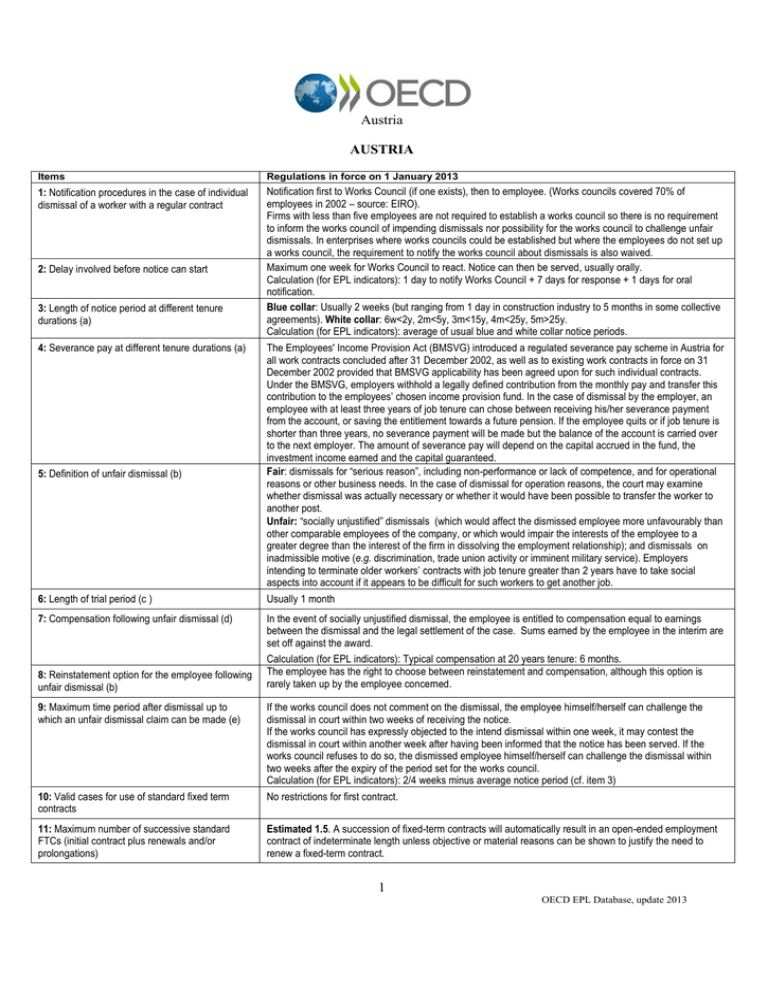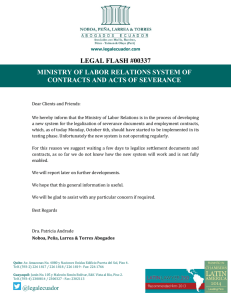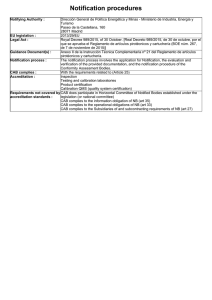Austria
Anuncio

Austria AUSTRIA Items Regulations in force on 1 January 2013 1: Notification procedures in the case of individual dismissal of a worker with a regular contract Notification first to Works Council (if one exists), then to employee. (Works councils covered 70% of employees in 2002 – source: EIRO). Firms with less than five employees are not required to establish a works council so there is no requirement to inform the works council of impending dismissals nor possibility for the works council to challenge unfair dismissals. In enterprises where works councils could be established but where the employees do not set up a works council, the requirement to notify the works council about dismissals is also waived. Maximum one week for Works Council to react. Notice can then be served, usually orally. Calculation (for EPL indicators): 1 day to notify Works Council + 7 days for response + 1 days for oral notification. Blue collar: Usually 2 weeks (but ranging from 1 day in construction industry to 5 months in some collective agreements). White collar: 6w<2y, 2m<5y, 3m<15y, 4m<25y, 5m>25y. Calculation (for EPL indicators): average of usual blue and white collar notice periods. 2: Delay involved before notice can start 3: Length of notice period at different tenure durations (a) 4: Severance pay at different tenure durations (a) 5: Definition of unfair dismissal (b) The Employees' Income Provision Act (BMSVG) introduced a regulated severance pay scheme in Austria for all work contracts concluded after 31 December 2002, as well as to existing work contracts in force on 31 December 2002 provided that BMSVG applicability has been agreed upon for such individual contracts. Under the BMSVG, employers withhold a legally defined contribution from the monthly pay and transfer this contribution to the employees’ chosen income provision fund. In the case of dismissal by the employer, an employee with at least three years of job tenure can chose between receiving his/her severance payment from the account, or saving the entitlement towards a future pension. If the employee quits or if job tenure is shorter than three years, no severance payment will be made but the balance of the account is carried over to the next employer. The amount of severance pay will depend on the capital accrued in the fund, the investment income earned and the capital guaranteed. Fair: dismissals for “serious reason”, including non-performance or lack of competence, and for operational reasons or other business needs. In the case of dismissal for operation reasons, the court may examine whether dismissal was actually necessary or whether it would have been possible to transfer the worker to another post. Unfair: “socially unjustified” dismissals (which would affect the dismissed employee more unfavourably than other comparable employees of the company, or which would impair the interests of the employee to a greater degree than the interest of the firm in dissolving the employment relationship); and dismissals on inadmissible motive (e.g. discrimination, trade union activity or imminent military service). Employers intending to terminate older workers’ contracts with job tenure greater than 2 years have to take social aspects into account if it appears to be difficult for such workers to get another job. 6: Length of trial period (c ) Usually 1 month 7: Compensation following unfair dismissal (d) In the event of socially unjustified dismissal, the employee is entitled to compensation equal to earnings between the dismissal and the legal settlement of the case. Sums earned by the employee in the interim are set off against the award. Calculation (for EPL indicators): Typical compensation at 20 years tenure: 6 months. The employee has the right to choose between reinstatement and compensation, although this option is rarely taken up by the employee concerned. 8: Reinstatement option for the employee following unfair dismissal (b) 9: Maximum time period after dismissal up to which an unfair dismissal claim can be made (e) If the works council does not comment on the dismissal, the employee himself/herself can challenge the dismissal in court within two weeks of receiving the notice. If the works council has expressly objected to the intend dismissal within one week, it may contest the dismissal in court within another week after having been informed that the notice has been served. If the works council refuses to do so, the dismissed employee himself/herself can challenge the dismissal within two weeks after the expiry of the period set for the works council. Calculation (for EPL indicators): 2/4 weeks minus average notice period (cf. item 3) 10: Valid cases for use of standard fixed term contracts No restrictions for first contract. 11: Maximum number of successive standard FTCs (initial contract plus renewals and/or prolongations) Estimated 1.5. A succession of fixed-term contracts will automatically result in an open-ended employment contract of indeterminate length unless objective or material reasons can be shown to justify the need to renew a fixed-term contract. 1 OECD EPL Database, update 2013 Austria 12: Maximum cumulated duration of successive standard FTCs No limit specified. 13: Types of work for which temporary work agency (TWA) employment is legal General, if the contract between the agency and the worker is open-ended but limited to "objective reasons" if it is of fixed duration. However, according to labour constitution law (Arbeitsverfassungsgesetz § 97 Abs 1 Z 1a) there is the possibility to regulate the extent of temporary work at the level of the user-company. In compliance with this law, assignments can be regulated by an enforceable company agreement. According to prevailing jurisprudence such a company agreement can contain regulations on the ratio of permanent staff to temporary workers and thereby limit the use of temporary workers at the user-company level. 14: Are there restrictions on the number of renewals and/or prolongations of TWA assignments? (f) There are no restrictions that limit the number of assignments at one and the same worksite company. The number of fixed-term contracts between the TWA and the temporary workers is not restricted, if there are objective and justified reasons to establish fixed-term contracts (otherwise a succession of fixed-term TWA contracts will automatically result in an open-ended employment contract of indeterminate length unless objective or material reasons can be shown to justify the need to renew a fixed-term contract.). 15: Maximum cumulated duration of TWA assignments (f) The personnel leasing act puts no constraint on the duration of employment contracts or the duration of the assignments/leases. 16: Does the set-up of a TWA require authorisation or reporting obligations? Requires special administrative authorisation as well as periodic reporting obligations. 17: Do regulations ensure equal treatment of regular workers and agency workers at the user firm? Regulations ensure equal treatment regarding pay as well as other working conditions. 18: Definition of collective dismissal (b) Within 30 days, 5+ workers in firms 20-99; 5%+ in firms 100-599; 30+ workers in firms>600; 5+ workers >50 years old. Firms with less than 20 employees are exempt from requirements for collective dismissals. 19: Additional notification requirements in cases of collective dismissal (g) Notification of employee representatives: General duty to inform the Works Council about changes affecting the business. Notification of public authorities: Notification of local employment office. 20: Additional delays involved in cases of collective dismissal (h) 30 days waiting period before first notice can become effective. Calculation (for EPL indicators): 30 days waiting period – 9 days for individual dismissal (item 2) 21: Other special costs to employers in case of collective dismissals (i) Type of negotiation required: Consultation on alternatives to redundancy and ways to mitigate the effects: social plan to be established in firms with >20 employees. Selection criteria: No criteria laid down by law. Severance pay: No legal requirements, but often part of social compensation plans. Legend: d: days; w: weeks; m: months; y: years. For example “1m < 3y” means “1 month of notice (or severance) pay is required when length of service is below 3 years”. Notes: a) Three tenure durations (9 months, 4 years, 20 years). Case of a regular employee with tenure beyond any trial period, dismissed on personal grounds or economic redundancy, but without fault (where relevant, calculations of scores to compute OECD EPL indicators assume that the worker was 35 years old at the start of employment). Averages are taken where different situations apply – e.g. blue collar and white collar; dismissals for personal reasons and for redundancy. b) Based also on case law, if court practice tends to be more (or less) restrictive than what specified in legislation. c) Initial period within which regular contracts are not fully covered by employment protection provisions and unfair dismissal claims cannot usually be made. d) Typical compensation at 20 years of tenure, including back pay and other compensation (e.g. for future lost earnings in lieu of reinstatement or psychological injury), but excluding ordinary severance pay and pay in lieu of notice. Where relevant, calculations of scores to compute OECD EPL indicators assume that the worker was 35 years old at the start of employment and that a court case takes 6 months on average. Description based also on case law. e) Maximum time period after dismissal up to which an unfair dismissal claim can be made. f) Description based on both regulations on number and duration of the contract(s) between the temporary work agency and the employee and regulations on the number and duration of the assignment(s) with the same user firm. g) Notification requirements to works councils (or employee representatives), and to government authorities such as public employment offices. Only requirements on top of those requirements applying to individual redundancy dismissal count for the OECD EPL indicators (cf. Item 1). h) Additional delays and notice periods in the case of collective dismissal (only delays on top of those required for individual dismissals – as reported in Items 2 and 3 – count for the OECD EPL indicators). i) This refers to whether there are additional severance pay requirements and whether social compensation plans (detailing measures of reemployment, retraining, outplacement, etc.) are obligatory or common practice. 2 OECD EPL Database, update 2013






